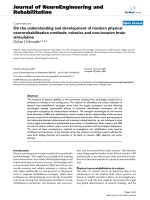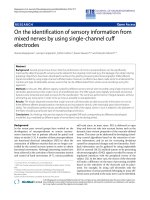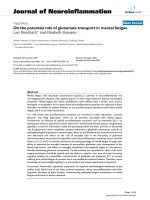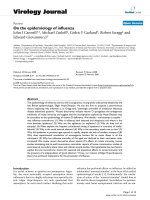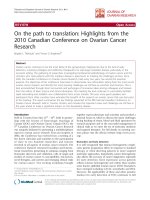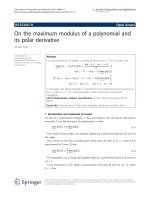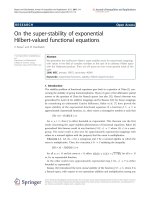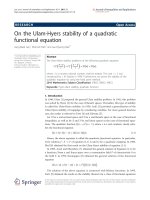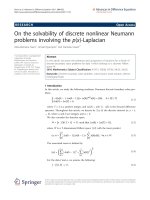Báo cáo hóa học: "ON THE MEAN SUMMABILITY BY CESARO METHOD OF FOURIER TRIGONOMETRIC SERIES IN TWO-WEIGHTED SETTING" ppt
Bạn đang xem bản rút gọn của tài liệu. Xem và tải ngay bản đầy đủ của tài liệu tại đây (547.01 KB, 15 trang )
ON THE MEAN SUMMABILITY BY CESARO METHOD OF
FOURIER TRIGONOMETRIC SERIES IN
TWO-WEIGHTED SETTING
A. GUVEN AND V. KOKILASHVILI
Received 26 June 2005; Revised 19 October 2005; Accepted 23 October 2005
The Cesaro summability of trigonometric Fourier seri es is investigated in the weighted
Lebesgue spaces in a two-weight case, for one and two dimensions. These results are ap-
plied to the prove of two-weighted Bernstein’s inequalities for trigonometric polynomials
of one and two variables.
Copyright © 2006 A. Guven and V. Kokilashvili. This is an open access article distributed
under the Creative Commons Attribution License, which permits unrestricted use, dis-
tribution, and reproduction in any medium, provided the original work is properly cited.
1. Introduction
It is well known that (see [9]) Cesaro means of 2π-periodic functions f
∈ L
p
(T)(1≤
p ≤∞) converges by norms. Hereby T is denoted the interval (−π,π). The problem of
the mean summability in weighted Lebesgue spaces has b een investigated in [6].
A2π-periodic nonnegative integrable function w :
T → R
1
is called a weight func-
tion. In the sequel by L
p
w
(T), we denote the Banach function space of all measurable
2π-periodic functions f , for which
f
p,w
=
T
f (x)
p
w(x)dx
1/p
< ∞. (1.1)
In the paper [6] it has been done the complete characterization of that weights w,
for which Cesaro means converges to the initial function by the norm of L
p
w
(T). Later
on Muckenhoupt (see [3]) showed that the condition referred i n [6]isequivalenttothe
condition A
p
, that is,
sup
1
|I|
I
w(x)dx
1
|I|
I
w
1−p
(x) dx
p−1
< ∞, (1.2)
where p
= p/(p − 1) and the supremum is taken over all one-dimensional intervals
whose lengths are not greater than 2π.
Hindawi Publishing Corporation
Journal of Inequalities and Applications
Volume 2006, Article ID 41837, Pages 1–15
DOI 10.1155/JIA/2006/41837
2 Mean summability of Fourier trigonometric series
The problem of mean summability by linear methods of multiple Fourier trigonomet-
ric series in L
p
w
(T) in the frame of A
p
classes has been studied in [5].
In the present paper we investigate the situation when the weight w canbeoutside
of A
p
class. Precisely, we prove the necessary and sufficient condition for the pair of
weights (v,w)whichgovernsthe(C,α) summability in L
p
v
(T) for arbitrary function f
from L
p
w
(T). This result is applied to the prove of two-weighted Bernstein’s inequality for
trigonometric polynomials. It should be noted that for monotonic pairs of weights for
(C,1) summability was studied in [7].
Let
f (x)
∼
a
0
2
+
∞
n=1
a
n
cos nx + b
n
sinnx
(1.3)
be the Fourier series of function f
∈ L
1
(T).
Let
σ
α
n
(x, f ) =
1
π
π
−π
f (x + t)K
α
n
(t)dt, α>0 (1.4)
when
K
α
n
=
n
k=0
A
α−1
n
−k
D
k
(t)
A
α
n
, (1.5)
with
D
k
(t) =
k
ν=0
sin(ν +1/2)t
2sin(1/2)t
,
A
α
n
=
n + α
α
≈
n
α
Γ(α +1)
.
(1.6)
In the sequel we will need the following well-known estimates for Cesaro kernel (see [9,
pages 94–95]):
K
α
n
(t) ≤ 2n, K
α
n
(t) ≤ c
α
n
−α
|t|
−(α+1)
(1.7)
when 0 <
|t| <π.
2. Two-weight boundedness and mean summability (one-dimensional case)
Let us introduce the certain class of pairs of weight functions.
Definit ion 2.1. Apairofweights(v,w)issaidtobeofclassᏭ
p
(T), if
sup
1
|I|
I
v(x)dx
1
|I|
I
w
1−p
(x) dx
p−1
< ∞, (2.1)
where the least upper bound is taken over all one-dimensional intervals by lengths not
more than 2π.
A. Guven and V. Kokilashvili 3
The following statement is true.
Theorem 2.2. Let 1 <p<
∞. Then
lim
n→∞
σ
α
n
(·, f ) − f
p,v
= 0 (2.2)
for arbitrary f from L
p
w
(T) if and only if (v,w) ∈ Ꮽ
p
(T).
The proof is based on the following statement.
Theorem 2.3. Let 1 <p<
∞. For the validity of the inequality
σ
α
n
(·, f )
p,v
≤ c f
p,w
(2.3)
for arbitrary f
∈ L
p
w
(T), where the constant c does not depend on n and f , it is necessary
and sufficient that (v,w)
∈ Ꮽ
p
(T).
Note that the condition (v,w)
∈ Ꮽ
p
(T) is also necessary and sufficient for boundedness of
the Abel-Poisson means from L
p
w
(T) to L
p
v
(T) [4].
First of all let us prove two-weighted inequality for the average
f
β
h
(x) =
1
h
1−β
x+h
x
−h
f (t)
dt, h>0, 0 ≤ β<1. (2.4)
The last functions are an extension of Steklov means.
Theorem 2.4. Let 1 <p<q<
∞ and let 1/q = 1/p− β. If the condition
sup
I
1
|I|
I
v(x)dx
1/q
1
|I|
I
w
1−p
(x) dx
1/p
< ∞ (2.5)
is satisfied for all intervals I,
|I|≤2π, then there exists a positive constant c such that for
arbitrary f
∈ L
p
w
(T) and h>0 the following inequality holds:
π
−π
f
β
h
(x)
q
v(x)dx
1/q
≤ c
π
−π
f (x)
p
w(x)dx
1/p
. (2.6)
Proof. Let h
≤ π and N be the least natural number for which Nh ≥ π. Then we have
T
f
β
h
(x)
q
v(x)dx
≤
N−1
k=−N
(k+1)h
kh
h
−q(1−β)
x+h
x
−h
f (t)
dt
q
v(x)dx
≤
N−1
k=−N
(k+1)h
kh
h
−q(1−β)
(k+2)h
(k
−1)h
f (t)
dt
q
v(x)dx
4 Mean summability of Fourier trigonometric series
≤
N−1
k=−N
(k+1)h
kh
h
−q(1−β)
(k+2)h
(k
−1)h
f (t)
p
w(t)dt
q/p
(k+2)h
(k
−1)h
w
1−p
(t)dt
q/p
v(x)dx
=
N−1
k=−N
(k+1)h
kh
v(x)dx
(k+2)h
(k
−1)h
w
1−p
(t)dt
q/p
h
−q(1−β)
×
(k+2)h
(k
−1)h
f (t)
p
w(t)dt
q/p
=
N−1
k=−N
1
h
(k+1)h
kh
v(x)dx
1
h
(k+2)h
(k
−1)h
w
1−p
(t)dt
q/p
(k+2)h
(k
−1)h
f (t)
p
w(t)dt
q/p
.
(2.7)
Arguing to the condition (2.5)weconcludethat
π
−π
f
β
h
(x)
q
v(x)dx ≤ c
N−1
k=−N
(k+2)h
(k
−1)h
f (t)
p
w(t)dt
q/p
. (2.8)
Using [2, Proposition 5.1.3] we obtain that
π
−π
f
β
h
(x)
q
v(x)dx ≤ c
1
f
q
p,w
. (2.9)
Theorem is proved.
Note that Theorem 2.4 is proved in [4] in the case β = 0.
Proof of Theorem 2.3. Let us show that
σ
α
n
(x, f )
≤
c
0
2π
1/n
1
n
α
h
−1−α
f
h
(x) dh, (2.10)
where the constant c
0
does not depend on f and h. By re versing the order of integration
in the right side integral of (2.10),wegetthatitismorethanorequalto
I
=
x+π
x
−π
f (t)
2π
max(
|x−t|,1/n)
1
n
α
h
−2−α
dh
dt
≥ c
x+π
x
−π
f (t)
1
n
α
max
|
x − t|,
1
n
−1−α
dt
(2.11)
since
|x − t|≤π.
Indeed, let us show that for
|x − t|≤π, the inequality
2π
max
{|x−t|,1/n}
h
−2−α
dh > c
max
|
x − t|,1/n
−α−1
, (2.12)
where c does not depend on x, t,andn.
A. Guven and V. Kokilashvili 5
It is obvious that
I
1
=
2π
max
{|x−t|,1/n}
h
−2−α
dh =
1
1+α
1
max
|
x − t|,1/n
1+α
−
1
(2π)
1+α
. (2.13)
To prove the latter inequality we consider two cases.
(a) Let
|x − t| < 1/n.Then
I
1
=
1
1+α
n
1+α
−
1
(2π)
1+α
>
1
1+α
1 − (2π)
−1−α
n
1+α
. (2.14)
(b) Let now
|x − t|≥1/n.Thenforthesakeofthefact|x − t|≤π,weconcludethat
I
1
=
1
1+α
1
|x − t|
1+α
−
1
(2π)
1+α
=
1
2(1 + α)
1
|x − t|
1+α
+
1
|x − t|
1+α
−
2
(2π)
1+α
>
1
2(1 + α)
1
|x − t|
1+α
+
1
π
1+α
−
2
(2π)
1+α
≥
1
2(1 + α)
1
|x − t|
1+α
+
1
π
1+α
−
1
2
α
π
1+α
>
1
2(1 + α)
1
|x − t|
1+α
(2.15)
which implies the desired result.
Using the estimates (1.7)weobtainthat
I
≥ c
x+π
x
−π
f (t)
K
α
n
(x − t)dt ≥ c
π
−π
f (t)K
α
n
(x − t)dt
=
c
σ
α
n
(x, f )
. (2.16)
Thus we obtain (2.10). Passing to the norms in (2.10), then applying Theorem 2.4 by
Minkowski’s integral inequality we obtain that
T
σ
α
n
(x, f )
p
v(x)dx ≤ c
T
f (x)
p
w(x)
1
n
α
1/n
h
−1−α
dh
p
dx
≤ c
1
T
f (x)
p
w(x)dx.
(2.17)
Now we will prove that from (2.3) it follows that (v,w)
∈ Ꮽ
p
(T). Ifthelengthofthe
interval I is more than π/4, the validness of the condition (2.1)isclear.
Let no w
|I|≤π/4. Let m be the greatest integer for which
m
≤
π
2|I|
−
1. (2.18)
Then we have
k +
1
2
(x − t)
≤
(m +1)|x − t|≤
π
2
. (2.19)
6 Mean summability of Fourier trigonometric series
Then applying Abel’s transform we get that for x and t from I, the following estimates are
true:
K
α
m
(x − t) ≥
m
k=0
A
α
m
−k
A
α
m
(2k +1)≥ c(m +2)
1
(m +1)A
α
m
m
k=0
A
α−1
m
−k
(k +1)
≥
c
|I|
1
(m +1)A
α
m
m
k=0
A
α
m
−k
=
c
|I|
A
α+1
m
(m +1)A
α
m
≥
c
|I|
.
(2.20)
Let us put in (2.3) the function
f
0
(x) = w
1−p
(x) χ
I
(x) (2.21)
for m which was indicated above. Then we obtain
I
I
w
1−p
(t)K
α
m
(x − t)dt
p
v(x)dx ≤ c
I
w
1−p
(x) dx. (2.22)
From the last inequality by (2.20)weconcludethat
I
1
|I|
I
w
1−p
(t)dt
p
v(x)dx ≤ c
I
w
1−p
(x) dx. (2.23)
Thus from (2.3) it follows that (v,w)
∈ Ꮽ
p
(T).
Proof of Theorem 2.2. Let us show that if (v,w) ∈ Ꮽ
p
(T), then
lim
n→∞
σ
α
n
(·, f ) − f
p,v
= 0 (2.24)
for arbitrary f
∈ L
p
w
(T).
Consider the sequence of linear operators:
U
n
: f −→ σ
α
n
·
, f
. (2.25)
It is easy to see that U
n
is bounded from L
p
w
(T)toL
p
v
(T). Indeed applying H
¨
older’s in-
equality we get
T
σ
α
n
(x, f )
p
v(x)dx ≤ 2n
T
T
f (t)
dt
p
v(x)dx
≤ 2n
T
f (t)
p
w(t)dt
T
v(x)dx
T
w
1−p
(x) dx
p−1
.
(2.26)
By our assumptions all these integrals are finite, the constant
c
= 2n
T
v(x)dx
T
w
1−p
(x) dx
p−1
(2.27)
does not depend on f.
A. Guven and V. Kokilashvili 7
Then since (v,w)
∈ Ꮽ
p
(T)byTheorem 2.3, we have that the sequence of operators
norms is bounded. On the other hand, the set of all 2π-periodic continuous on the line
functions is dense in L
p
w
(T). It is known (see [9]) that the Cesaro means of continuous
function uniformly converges to the initial function and since v
∈ L
1
(T)theyconverge
in L
p
v
(T) as well. Applying the Banach-Steinhaus theorem (see, [1]) we conclude that the
convergence holds for arbitrary f
∈ L
p
w
(T).
Now we prove the necessity part. From the convergence in L
p
v
(T) of the Cesaro means
by Banach-Steinhaus theorem we conclude that
U
n
L
p
w
(T)→L
p
v
(T)
∞
n=1
(2.28)
is bounded. It means that (2.3)holds.ThenbyTheorem 2.3 we conclude that (v,w)
∈
Ꮽ
p
(T).
Theorem is proved.
3. On the mean (C, α, β) summability of the double trigonometric Fourier series
Let
T
2
=
T × T
and f (x, y) be an integrable function on T
2
which is 2π-periodic with
respecttoeachvariable.
Let
f (x, y)
∼
∞
m,n=0
λ
mn
a
mn
cos mx cosny+ b
mn
sinmxsinmy
+ c
mn
cos mx sinny+ d
mn
sinmxsinny
,
(3.1)
where
λ
mn
=
⎧
⎪
⎪
⎪
⎪
⎪
⎪
⎨
⎪
⎪
⎪
⎪
⎪
⎪
⎩
1
4
,whenm
= n = 0,
1
2
,form
= 0, n>0orm>0, n = 0,
1, when m>0, n>0.
(3.2)
Let
σ
(α,β)
mn
(x, y, f ) =
m
i
=0
n
j
=0
A
α−1
m
−i
A
β−1
n
− j
S
ij
(x, y, f )
A
α
m
A
β
n
,(α,β>0) (3.3)
be the Cesaro means for the function f ,whereS
ij
(x, y, f )arepartialsumsof(3.1).
We consider the mean summability in weighted space defined by the norm
f
p,w
=
T
2
f (x, y)
p
w(x, y)dxdy
1/p
, (3.4)
where w is a weight function of two variables.
In this section our goal is to prove the following result and some its converse.
8 Mean summability of Fourier trigonometric series
Theorem 3.1. Let 1 <p<
∞. Assume that the pair of weights (v,w) satisfies the condition
sup
J
1
|J|
J
v(x, y)dxdy
1
|J|
J
w
1−p
(x, y)dxdy
p−1
< ∞, (3.5)
where the least upper bound is taken over all rectangles, with the sides parallel to the coordi-
nate axes. Then for arbitrar y f
∈ L
p
w
(T
2
),wehave
lim
m→∞
n→∞
σ
(α,β)
mn
(·,·, f ) − f
p,v
−→ 0. (3.6)
In the sequel the set of all pairs with the condition (3.5) will be denoted by Ꮽ
p
(T
2
,J).
Here
J denotes the set of all rectangles with parallel to the coordinate axes.
The proof of this theorem is based on the following statement.
Theorem 3.2. Let 1 <p<
∞ and (v,w) ∈ Ꮽ
p
(T
2
,J), then
σ
(α,β)
mn
(·,·, f )
p,v
≤ c f
p,w
, (3.7)
w ith the constant c independent of m, n,and f .
To prov e Theorem 3.2 we need the two-dimensional version of Theorem 2.4.Letus
consider generalized multiple Steklov means
f
γ
hk
(x) = sup
h>0
k>0
1
(hk)
γ
x+h
x
−h
y+k
y
−k
f (t,τ)
dtdτ,0<γ≤ 1. (3.8)
Theorem 3.3. Let 1 <p<
∞ and 1/q = 1/p− γ.Let(v,w) ∈ Ꮽ
p
(T
2
,J). Then there exists
a constant c>0 such that for arbitrary f
∈ L
p
w
(T
2
) and positive h and k,wehave
f
γ
hk
q,v
≤ c f
p,w
. (3.9)
Proof. Let h
≤ π and k ≤ π. Let M and N be the least natural numbers for which Mh ≥ π
and Nk
≥ π. Then
T
2
f
γ
hk
(x, y)
q
v(x, y)dxdy ≤
M
i=−M
N
j=−N
(i+1)h
ih
( j+1)k
jk
(hk)
−q(1−γ)
×
x+h
x
−h
y+k
y
−k
f (t,τ)
dtdτ
q
v(x, y)dxdy
≤
M−1
i=−M
N
−1
j=−N
(i+1)h
ih
( j+1)k
jk
(hk)
−q(1−γ)
×
(i+2)h
(i
−1)h
( j+1)k
( j
−1)k
f (t,τ)
dtdτ
q
v(x, y)dxdy.
(3.10)
A. Guven and V. Kokilashvili 9
Using the H
¨
older’s inequality we get
T
2
f
γ
hk
(x, y)
q
v(x, y)dxdy
≤
M−1
i=−M
N
−1
j=−N
(i+1)h
ih
( j+1)k
jk
(hk)
−q(1−γ)
(i+2)h
(i
−1)h
( j+1)k
( j
−1)k
f (t,τ)
p
w(t,τ)dtdτ
q/p
×
(i+2)h
(i
−1)h
( j+2)k
( j
−1)k
w
1−p
(x, y)dxdy
q/p
v(x, y)dxdy.
(3.11)
By the condition Ꮽ
p
(T
2
,J)wederivethat
T
2
f
γ
hk
(x, y)
q
v(x, y)dxdy ≤ c
M−1
i=−M
N
−1
j=−N
(i+2)h
(i
−1)h
( j+1)k
( j
−1)k
f (t,τ)
p
w(t,τ)dtdτ
q/p
.
(3.12)
Consequently,
T
2
f
γ
hk
(x, y)
q
v(x, y)dxdy ≤ c f
q
p,w
. (3.13)
Theorem is proved.
Proof of Theorem 3.2. Let us prove that
σ
(α,β)
mn
(x, y, f )
≤
c
π
1/m
π
1/n
1
m
α
n
β
h
−1−α
k
−1−β
f
hk
(x, y, f )dhdk, (3.14)
where the constant does not depend on f , x, y, m,andn.
If we reverse the order of integration in right side of (3.14), then by the arguments
similar to that of the one-dimensional case we obtain that
I
=
x+π
x
−π
y+π
y
−π
f (t,s)
2π
max(
|x−t|,1/m)
2π
max(
|y−s|,1/n)
1
m
α
n
β
h
−2−α
k
−2−β
dhdk
dtds
≥ c
x−π
x+π
y+π
y
−π
f (t,s)
1
m
α
n
β
max
|
x − t|,
1
m
−1−α
max
|
y − s|,
1
n
−1−β
dtds.
(3.15)
Applying the known estimates for Cesaro kernel from the last estimate we derive that
I
≥ c
T
2
f (t,s)
K
α
m
(x − t)K
β
n
(y − s)dtds ≥ c
σ
(α,β)
mn
(x, y, f )
. (3.16)
We proved (3.14).
10 Mean summability of Fourier trigonometric series
Taking the norms in (3.14), by Theorem 3.3 and Minkowski’s inequality we conclude
that
T
2
σ
(α,β)
mn
(x, y, f )
p
v(x, y)ddxdy
≤ c
T
2
f (x, y)
p
w(x, y)
1
m
α
n
β
2π
1/m
2π
1/n
h
−1−α
k
−1−β
dhdk
p
dxdy
≤ c
1
T
2
f (x, y)
p
w(x, y)dxdy.
(3.17)
By this we obtain (3.7).
Proof of Theorem 3.1. Consider the sequence of operators
U
mn
: f −→ σ
(α,β)
mn
(·,·, f ). (3.18)
It is evident that U
mn
is linear bounded for each (m,n)as
T
2
v(x, y)dxdy < ∞,
T
2
w
1−p
(x, y)dxdy < ∞. (3.19)
Then since (v, w)
∈ Ꮽ
p
(T
2
,J)byTheorem 3.2, the sequence of operators norms
U
mn
L
p
w
→L
p
v
∞
m,n=1
(3.20)
is bounded. On the other hand, the set of 2π-periodic functions which are continuous on
the plane is dense in L
p
w
(T
2
). Then it is known that Cesaro means of Lipschitz functions
of two variables converges uniformly (see [8, page 181]). Since v
∈ L
1
(T
2
) the last conver-
gence we have by means of L
p
v
norms as well. Applying the Banach-Steinhaus theorem (see
[1]) we conclude that the norm convergence (3.6)holdsforarbitrary f
∈ L
p
w
(T
2
).
Theorem 3.4. Let 1 <p<∞. If the inequality (3.7) is satisfied, then the condition (3.5)
holds when the least upper bound is taken over all rectangles J
0
= I
1
× I
2
and |I
1
| <π/4 and
|I
2
| <π/4.
Proof. Let m and n be that greatest natural numbers with
π
2(m +2)
≤
I
1
≤
π
2(m +1)
,
π
2(n +2)
≤
I
2
≤
π
2(n +1)
. (3.21)
Then for (x, y)
∈ J
0
and (t,τ) ∈ J
0
,wehave
K
α
m
(x − t) ≥
c
|I
1
|
, K
β
n
(y − s) ≥
c
|I
2
|
(3.22)
with some constant c nondepending on m, n,(x, y)and(t,s).
A. Guven and V. Kokilashvili 11
Indeed Abel’s transform for K
α
m
gives
K
α
m
(x − t) ≥
m
k=0
A
α
m
−k
A
α
m
(2k +1)≥ c(m +2)
1
(m +1)A
α
m
m
k=0
A
α−1
m
−k
(k +1)
≥
c
|I
1
|
1
(m +1)A
α
m
n
k=0
A
α
k
=
c
|I
1
|
A
α+1
m
(m +1)A
α
m
≥
c
|I
1
|
,
(3.23)
for (x, y)
∈ J
0
and (t,s) ∈ J
0
.
Analogously we can estimate K
β
n
(y − s).
Now for indicated m and n,put(3.7) in the function
f
0
(x, y) = w
1−p
(x, y)χ
J
0
(x, y). (3.24)
Then we get
J
0
J
0
w
1−p
(t,s)K
α
m
(x − t)K
β
n
(y − s)dtds
p
v(x, y)dxdy ≤ c
J
0
w
1−p
(x, y)dxdy.
(3.25)
By (3.23) from the last inequality we obtain
J
0
1
|J
0
|
J
0
w
1−p
(t,s)dtds
p
v(x, y)dxdy ≤ c
J
0
w
1−p
(x, y)dxdy, (3.26)
which is (3.5) with the least upper bound taken over all rectangles J
0
,suchthatJ
0
= I
1
× I
2
and |I
i
| <π/4, i = 1,2.
Theorem 3.5. Let 1 <p<∞. If (3.7) holds, then there exist k ∈ N and a positive c>0 such
that
1
|J|
J
v(x, y)dxdy
1
|J|
J
w
1−p
(x, y)dxdy
p−1
<c (3.27)
for arbitrary J
= I
1
× I
2
with |I
i
| <π/(2k +1)(i = 1,2).
Proof. Let us consider the double sequence of operators
U
mn
: f −→ σ
(α,β)
mn
(·,·, f ). (3.28)
Since the sequence is double, following to the proof of Banach-Steinhaus theorem, we
can conclude only t hat t here exists some natural number k such that
U
mn
≤
M (3.29)
when m
≥ k, n ≥ k.
12 Mean summability of Fourier trigonometric series
Note that, in general the convergence of a double sequence does not imply the bound-
edness of this sequence. Thus we have that
σ
(α,β)
mn
(·,·, f )
p,v
≤ c f
p,w
(3.30)
when m
≥ k and n ≥ k.
Let us consider such rectangles that J
0
= I
1
× I
2
and
I
1
<
π
2(k +1)
,
I
2
<
π
2(k +1)
. (3.31)
Then choose the greatest m and n such that
π
2(m +2)
<
I
1
<
π
2(m +1)
,
π
2(n +2)
<
I
2
<
π
2(n +1)
. (3.32)
Now it is sufficient to repeat the last part of the proof of previous theorem.
4. Two-weighted Bernstein’s inequalities
Applying the two-norm inequalities for the Cesaro means derived in the previous sec-
tions, we are able to prove the two-weighted version of the well-known Bernstein’s in-
equality. For any trigonometric polynomial T
n
(x)oforder≤ n,foreveryp (1 ≤ p ≤∞),
we have
2π
0
T
n
(x)
p
dx
1/p
≤ cn
2π
0
T
n
(x)
p
dx
1/p
. (4.1)
The last inequality is known as integral Bernstein’s inequality.
The following extension of (4.1)istrue.
Theorem 4.1. Let 1 <p<
∞ and assume that (v, w) ∈ Ꮽ
p
(T). Then the two-weighted in-
equality
2π
0
T
n
(x)
p
v(x)dx
1/p
≤ cn
2π
0
T
n
(x)
p
w(x)dx
1/p
(4.2)
holds. Also for the conjugate trigonometric polynomial
T
n
,wehave
2π
0
T
n
(x)
p
v(x)dx
1/p
≤ cn
2π
0
T
n
(x)
p
w(x)dx
1/p
. (4.3)
Proof. It is well known that
T
n
(x) =
1
π
2π
0
T
n
(u)D
n
(u − x)du, (4.4)
where
D
n
(u) =
1
2
+
n
k=1
cos ku (4.5)
A. Guven and V. Kokilashvili 13
is the Dirichlet’s kernel of order n. By the derivation, we obtain
T
n
(x) =−
1
π
2π
0
T
n
(u)D
n
(u − x)du =−
1
π
2π
0
T
n
(u + x)D
n
(u)du
=
1
π
2π
0
T
n
(u + x)
n
k=1
k sinku
du
=
1
π
2π
0
T
n
(u + x)
n
k=1
k sinku+
n−1
k=1
k sin(2n − k)u
du
=
1
π
2π
0
T
n
(u + x)2nsinnu
1
2
+
n−1
k=1
n − k
n
cos ku
du
= 2n
1
π
2π
0
T
n
(u + x)sinnuK
n−1
(u)du,
(4.6)
where K
n−1
is the Fejer’s kernel of order n − 1. By taking the absolute values, we get (see
[9, Volume I, page 85])
T
n
(x)
≤
2n
1
π
2π
0
T
n
(u + x)
K
n−1
(u)du = 2nσ
n−1
x,
T
n
. (4.7)
If we use Theorem 2.3,wegetthat
2π
0
T
n
(x)
p
v(x)dx
1/p
≤
2π
0
2nσ
n−1
x,
T
n
p
v(x)dx
1/p
= 2n
2π
0
σ
n−1
x,
T
n
p
v(x)dx
1/p
≤ cn
2π
0
T
n
p
w(x)dx
1/p
.
(4.8)
For the conjugate of T
n
,wehave
T
n
(x) =
1
π
2π
0
T
n
(u)
D
n
(u − x)du, (4.9)
where
D
n
=
n
k=1
sinku (4.10)
is the conjugate Dirichlet’s kernel. By differentiation we get
T
n
(x) =
2n
π
2π
0
T
n
(x + u)cosnuK
n−1
(u)du (4.11)
14 Mean summability of Fourier trigonometric series
and hence
T
n
(x)
≤
2nσ
n−1
x,
T
n
. (4.12)
From this we obtain
2π
0
T
n
(x)
p
v(x)dx
1/p
≤ cn
2π
0
T
n
(x)
p
w(x)dx
1/p
. (4.13)
and the theorem is proved.
The inequality derived in Theorem 4.1 also extended to the case of trigonometric poly-
nomials of several variables. Thus, if T
mn
(x, y) is a trigonometric polynomial of order ≤ m
with respect to x and of order
≤ n with respect to y, we have the following.
Theorem 4.2. Let 1 <p<
∞. Assume that (v,w) ∈ Ꮽ
p
(T
2
,J). Then the inequality
∂
2
T
mn
(x, y)
∂x∂y
p,v
≤ cmn
T
mn
(x, y)
p,w
(4.14)
holds with a positive constant c independent of T
mn.
Proof. It is known that (see [9, Volume II, pages 302–303])
σ
mn
(x, y) =
1
π
2
2π
0
f (x + s, y + t)K
m
(s)K
n
(t)dsdt,
T
mn
(x, y) =
1
π
2
2π
0
T
mn
(s,t)D
m
(s − x)D
n
(t − y)dsdt.
(4.15)
If we take the par tial derivatives of T
mn
with respect to x and y from the last relation, we
obtain
∂
2
T
mn
(x, y)
∂x∂y
=
1
π
2
2π
0
T
mn
(s,t)D
m
(s − x)D
n
(t − y)dsdt. (4.16)
By the process used in the previous theorem, this gives
∂
2
T
mn
(x, y)
∂x∂y
=
2m2n
π
2
2π
0
T
mn
(x + s, y + t)sinmssinntK
m−1
(s)K
n−1
(t)dsdt (4.17)
and hence
∂
2
T
mn
(x, y)
∂x∂y
≤
4mn
π
2
σ
(m−1)(n−1)
x, y,
T
mn
. (4.18)
If we take the norms and consider Theorem 3.2, we obtain the desired inequality.
Acknowledgments
Part of research was carried out when the second author was visiting the Department of
Mathematics at Balikesir University and was supported by Nato-D Grant of T
¨
UB
˙
ITAK.
The authors are grateful to the referee for valuable remarks and suggestions.
A. Guven and V. Kokilashvili 15
References
[1] S. Banach and H. Steinhaus, Sur le principe de condensation de singularit
´
es, Fundamenta Mathe-
maticae 9 (1927), 50–61.
[2] V. Kokilashvili and M. Krbec, Weighted Inequalities in Lorentz and Orlicz Spaces, World Scientific,
New Jersey, 1991.
[3] B. Muckenhoupt, Weighted norm inequalities for the Hardy maximal function, Transactions of
the American Mathematical Society 165 (1972), 207–226.
[4]
, Two weight function norm inequalities for the Poisson integral, Transactions of the Amer-
ican Mathematical Society 210 (1975), 225–231.
[5] A. D. Nakhman and B. P. Osilenker, Estimates of weighted norms of some operators generated by
multiple trigonometric Fourier series, Izvestiya Vysshikh Uchebnykh Zavedeni
˘
ı. Matematika 239
(1982), no. 4, 39–50 (Russian).
[6] M. Rosenblum, Summability of Fourier series in L
p
(dμ), Transactions of the American Mathe-
matical Society 105 (1962), no. 1, 32–42.
[7] Ts. Tsanava, On the Fourier operators in weighted Lebesgue spaces, Proceedings of A. Razmadze
Mathematical Institute 138 (2005), 107–109.
[8] L. V.
ˇ
Zi
ˇ
zia
ˇ
svili, Conjugate Functions and Trigonometric Se ries, Izdat. Tbilis. Univ., Tbilisi, 1969.
[9] A. Zygmund, Trigonometric Series. Vols. I, II, 2nd ed., Cambridge University Press, New York,
1959.
A. Guven: Depart ment of Mathematics, Faculty of Art and Science, Balikesir University,
10145 Balikesir, Turkey
E-mail address:
V. Kokilashvili: International Black Sea University, 0131 Tbilisi, Georg i a
E-mail address:
